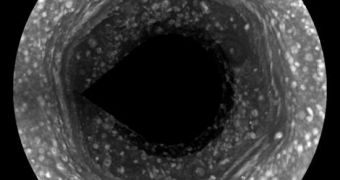In the early 1980s, as the Voyager probe was passing by Saturn, it noticed one of the most peculiar space structures that experts had ever seen. The formation, which is roughly hexagon-shaped, is still a mystery for astronomers. Theories as to its origins abound, but none of them has managed to make itself established and widely accepted in the international scientific community. The hexagon encircles Saturn with a diameter roughly equal to two Earths, Space reports. The Cassini spacecraft, in orbit around the gas giant since 2004, has recently been able to photograph the structure again.
Most likely, scientists seem to believe, the structure is a cloud-generated formation, which is able to endure for many years. The jet stream that is thought to be responsible for the creation of the hexagonal clouds keeps flowing at the planet's north pole, the experts say. It is estimated at this point that the jets are capable of slamming into the clouds at speeds exceeding 220 miles per hour (100 meters per second). The clouds were imaged for the last time more than 30 years ago, as the last spring began on the surface of Saturn.
“The longevity of the hexagon makes this something special, given that weather on Earth lasts on the order of weeks. It's a mystery on par with the strange weather conditions that give rise to the long-lived Great Red Spot of Jupiter,” California Institute of Technology (Caltech) Cassini imaging team associate Kunio Sayanagi, who has been a part of the new investigation, says. He adds that, 15 years after the original Voyager photos were captured, the Saturnine north pole was enveloped in darkness.
Unlike its predecessor, the new space probe benefits from a better viewing angle, which allows it to position itself better for observing the Hexagon. It also carries massively improved scientific payloads, including high-resolution cameras and spectrometers, which allow it to collect as much information as possible about its targets, while using limited means. The new photos were taken in infrared, and reveal that the cloudy structure is still in place, and also very extended within the gas giant's atmosphere.
“Now that we can see undulations and circular features instead of blobs in the hexagon, we can start trying to solve some of the unanswered questions about one of the most bizarre things we've ever seen in the solar system. Solving these unanswered questions about the hexagon will help us answer basic questions about weather that we're still asking about our own planet,” NASA Jet Propulsion Laboratory (JPL) atmospheric scientist Kevin Baines concludes. JPL is managed by Caltech, in Pasadena.

 14 DAY TRIAL //
14 DAY TRIAL //